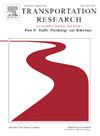Driver’s gaze behavior when approached by an emergency vehicle – The effects of in-car warnings and system introduction
IF 3.5
2区 工程技术
Q1 PSYCHOLOGY, APPLIED
Transportation Research Part F-Traffic Psychology and Behaviour
Pub Date : 2025-02-01
DOI:10.1016/j.trf.2024.12.010
引用次数: 0
Abstract
This study investigates drivers’ eye gaze behavior in response to Emergency Vehicle Approaching (EVA) warnings. EVA warnings, delivered through in-car alerts, provide advance notice of approaching EVs, enabling drivers to move over in time. Previous research indicates that EVA warnings influence driver behavior positively, promoting safer interactions. This study expands further by exploring the role of system introduction to make drivers benefit from EVA warnings.
A simulator experiment with 73 participants was conducted. Before driving, half of the participants were introduced to the EVA system. The participants were driving on a highway and were overtaken by EVs twice during a 20-minute drive. During the drive, half of participants received EVA warnings. Gaze distribution was analyzed in three areas of interest (Forward, Mirrors, Dashboards). Analysis of driving simulator data did not reveal any differences in driving behaviors. However, the analysis of drivers’ gaze distribution suggests that EVA warnings contribute to increased mirror usage, indicating early scanning for approaching EVs. Furthermore, drivers who were introduced to the EVA system before driving but never received an EVA warning in the simulator looked through the front windshield less than drivers who were introduced and received an EVA warning.
This study contributes to understanding the driver gaze behavior when receiving an in-car warning for emergency vehicles and supports previous findings regarding EVA warnings positive impact of driver behavior.
求助全文
约1分钟内获得全文
求助全文
来源期刊
CiteScore
7.60
自引率
14.60%
发文量
239
审稿时长
71 days
期刊介绍:
Transportation Research Part F: Traffic Psychology and Behaviour focuses on the behavioural and psychological aspects of traffic and transport. The aim of the journal is to enhance theory development, improve the quality of empirical studies and to stimulate the application of research findings in practice. TRF provides a focus and a means of communication for the considerable amount of research activities that are now being carried out in this field. The journal provides a forum for transportation researchers, psychologists, ergonomists, engineers and policy-makers with an interest in traffic and transport psychology.

 求助内容:
求助内容: 应助结果提醒方式:
应助结果提醒方式:


